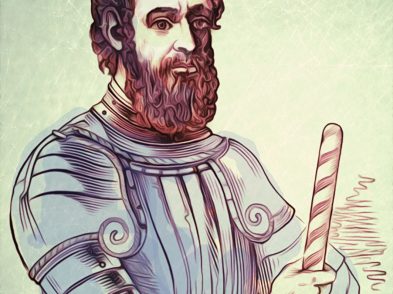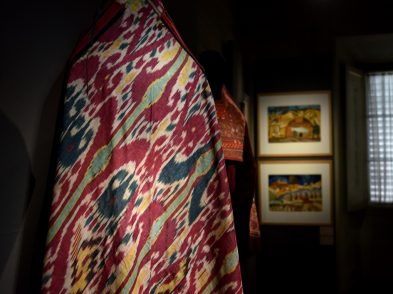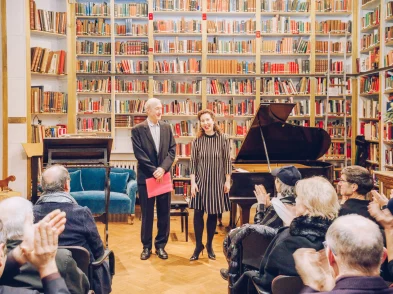A treasure trove of trompe l’oeil painting, a stone prison turned into a showplace for sculpture, and a workshop for exquisite pietra dura creations: a visit to these three gems of Florence offer a rich visual experience that will leave you pondering the distinction between art and craft.
Museo dell’Opificio delle Pietre Dure
(semi-precious stone workshop)
via degli Alfani, 78
Hours: Monday–Saturday, 8:15–2:00; Thursday 8:15–7:00; closed Sunday.
Entrance fee: 2 euro
Tel: 055/2651357
Founded in 1588 by Grand Duke Ferdinando de’ Medici as a master artisan workshop, the opificio was originally located in a wing of the Uffizi. It was created in order to produce the decorative mosaics in hard and semi-hard stone in the Medici Chapels and in the Cappella dei Principi in the San Lorenzo church. The workshop, called the Manifattura delle Pietre Dure, moved to its present location in 1796 and became a museum in 1882.
A conservation and restoration laboratory, which is not open to the public, was founded in 1932; its school, founded in 1978, does cutting-edge research on the restoration of stone, marble, bronze and terra cotta.
This special museum, not far from the Accademia, is well worth seeing. Dedicated to precious stone (pietra dura) scagliola, painting in stone, and other artisan work tools, the museum gives insight into the techniques of this remarkable craft. Pietre dure work, which for all its complexity is very durable, and is characterized by decorations of flowers, fruits and birds depicted on a dark background. The table of Apollo and the Muses, which took 14 years to make and was completed in 1853, is the last work of the opificio. Many pieces of pietre dure from the time of the Grand Duchy are still in the courtyard today.
Museo Nazionale del Bargello
via del Proconsolo, 4
Open: 8:15–1:50, Tuesday–Saturday; 2nd and 4th Sundays; 1st, 3rd and 5th Mondays.
Entrance fee: 4 euro
Tel: 055/2388606
The Bargello, or the Palazzo del Popolo (Palace of the People), was a former barracks and prison. (Bargello means ‘castle’ or ‘fortified tower’ in Italian.) It was constructed in 1255 to house the Capitano del Popolo (Captain of the People) and later, in 1261, it housed the Podestà, the highest magistrate of the city council. Originally called the Palazzo del Podestà, the Ba
rgello is the oldest public building in Florence and served as model for the Palazzo Vecchio. In 1574, when the function of the Podestà was abolished, it became the house of the bargello, the police chief of Florence. It then became a prison. Executions took place in the courtyard until capital punishment was abolished in 1786. However, it remained the headquarters of the Florentine police force until 1865. The final transformation began in 1859, when the Uffizi transferred its sculpture and applied arts to the Bargello. It was opened to the public for the first time in 1865 and in 1887 became the National Museum of the Bargello.
The Uffizi is Florence’s painting museum; the Bargello, with its concentration on Gothic and Renaissance art, is Florence’s sculpture museum. The myriad famous pieces to view and admire include Donatello’s exquisite bronze David; his Marzocco (in pietra serena), the lion emblem and symbol of Florence; and his bas relief St. George, originally located in one of the niches on the Orsanmichele. On view is Michelangelo’s marble bust of Brutus (the only bust he ever sculpted); his David-Apollo piece, created after the David in the Accademia; the Pitti Tondo; and his wonderful drunken Bacchus. Visitors can also admire Cellini’s Narcissus and his wax and bronze models for Perseus; Giambologna’s famous bronze Mercury; and Ghiberti and Brunelleschi’s famed reliefs of the sacrifice of Isaac, created for the competition of the Baptistry doors.
Finally, the stunning Della Robbia room and the Chapel of Mary Magdalene, completed in the 14th century and later converted into prison cells, are each a must-see. The frescoes located in the chapel were initially attributed to Giotto in 1874. Historians later ascribed them to one of the exponents of the Giotto school. The fresco entitled Paradise, located on the main alter wall, is a portrait of Dante clothed in dark red.
This superb collection of Florentine Renaissance sculpture is not to be missed!








